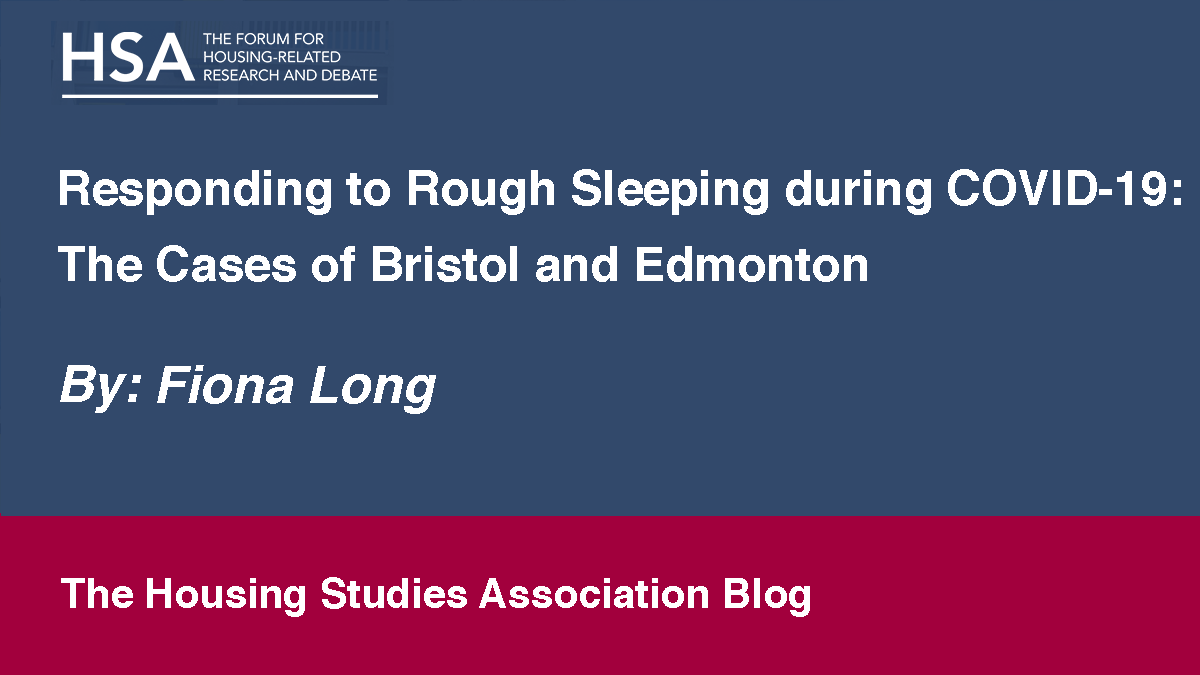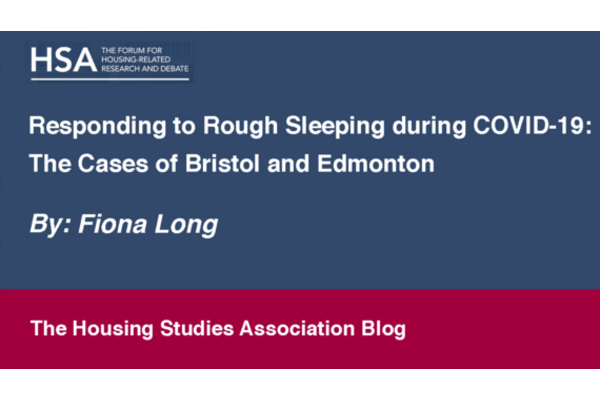
Responding to Rough Sleeping during COVID-19: The Cases of Bristol and Edmonton
Fiona Long is a final year PhD student at Cardiff University and is taking an ethnographic approach to life at a homeless hostel. At the time of writing, she is embarking upon a 3-month research project at the University of Alberta in Edmonton, Canada, a project which has been funded jointly by the UKRI and Mitacs, and has been co-designed with her host supervisor, Dr Joshua Evans.
For the 2022 Housing Studies Association Conference, participants were encouraged to work ‘across boundaries in theory, research, and practice’. It is therefore fortuitous that I’ve just embarked upon Globalink’s UK-Canada exchange programme, as although the project is still in its infancy, it has already facilitated a comparison of different geographies, academic disciplines, and housing practices. Initial discussions have been unavoidably comparative: ‘X works like this in Bristol, how about in Edmonton?’ or ‘we have a lot of Y in Edmonton, is the picture similar in Bristol?’ Focusing on just one prominent point of comparison, this blog post will give a brief overview of the approaches to rough sleeping taken during the COVID-19 pandemic in Bristol, England and Edmonton, Canada.
COVID-19
Following the outbreak of COVID-19, people around the world were being urged to ‘stay at home!’ ‘Home’ therefore became conceptualized as a place of safety and refuge, a protective barrier to the spread of this deadly virus. And whilst this wasn’t always the case (Gurney, 2020), staying inside did facilitate physical segregation from other, potentially infectious, people. However, this seemed an absurd request to make of those sleeping rough, a group of people who, by definition, had no home to stay in. Ironically, this group of people were also thought to be particularly vulnerable to infection. In response, unprecedented sums of money were devoted around the world to solving this very predicament (Parsell et al, 2020). Whilst we were all experiencing the same pandemic, our practical responses to housing this population have been very different, as can be seen in the cases of Bristol and Edmonton.
Bristol, England
Days after the ‘stay at home’ announcement in March 2020, MP Luke Hall sent out two letters: the first to hotels, hostels, and B&Bs, requesting that their premises be used to temporarily accommodate those sleeping rough; the second to local authorities with a clear strategy for getting people in and the promise of funding. And so, the ‘Everyone In’ initiative was born. Bristol’s Mayor put out a call for accommodation and by mid-April had sourced 323 units of across five venues. Individuals were assigned a venue based on whether they were symptomatic, medical vulnerability, and level of support needs. The initiative was clear and effective, a theme seen across England (Fitzpatrick, Watts and Sims, 2020). At the same time, emergency shelter spaces were closed, as it was not considered possible to socially distance within these spaces.
However, by May the government’s focus had shifted, from getting everyone in, to getting everyone into the system, by moving ‘ex rough sleepers’ into the existing housing provision whilst withdrawing funding for the initiative. This signified the beginning of the end of the Everyone In initiative. In a new letter, MP Luke Hall brought forward funding for the provision of additional housing units, to increase the existing housing provision. In Bristol, this largely took the form of a development known as Parkview, or Imperial Apartments, a former office block turned into 216 small flats. Whilst the development was not ideal, particularly as the developer had previously been accused of ‘human warehousing’, pressures from above made this the ‘least worst option’ in the Mayor’s eyes (Roig, 2021).
Edmonton, Canada
In Edmonton, the picture was slightly different. Due to the scale of rough sleeping (around 461 people in late 2019), huge reliance on emergency shelter spaces (just over 600 spaces for the same period), and freezing temperatures (lows of -40 degrees), it became near impossible to close the emergency shelters. Instead, provincial funding was used to open two additional shelter spaces, enabling the existing shelters to reduce their capacity and practice social distancing. However, both additional shelters closed in July 2020, the Expo Centre when the funding ran out, and the Kinsmen Centre when it re-opened as a recreation centre (Evans et al, 2021).
In response to the government’s perceived lack of action, Camp Pekiwewin – a self-funded, Indigenous-led prayer camp – was formed, providing food, first aid, and naloxone to up to 170 tent homes. Unhappy with this grassroots encampment, the province responded by providing additional funding, which facilitated the re-opening of the Expo Centre as well as the opening of the Convention Centre, a culturally adequate site for Indigenous peoples. This was an important move, given that Indigenous peoples are hugely overrepresented within the homeless population.
How do they compare?
In the wake of COVID-19, both cities saw an increased drive to spatially manage the rough sleeping populations as they scrambled to get everybody off the streets. However, each city followed their own trajectory, shedding light on some of the key issues faced more generally by each. Bristol’s response started off as a flood which gradually turned into a trickle, as it encountered localism and a lack of affordable housing along the way. Edmonton’s response was rocky to begin with before finding its feet, coming up against resistance and grappling with the culturally specific needs of Indigenous peoples experiencing homelessness. This whistle-stop summary of each city’s response offers scope for further comparison and interrogation, forming the foundation of my project here in Edmonton.
References
Evans, J. Stout, M. Collins, D. and McDowell, K. 2021. The reticent state? Interpreting emergency responses to homelessness in Alberta, Canada. Housing Studies, pp.1-14.
Fitzpatrick, S, Watts, B, and Sims, R. 2020. Homelessness Monitor England 2020: COVID-19 Crisis Response Briefing. Available at: www. crisis. org. uk/ending-homelessness/homelessnessknowledge-hub/homelessness-monitor/england/homelessness-monitor-england-2020-covid-19-crisisresponse-briefing [Accessed: 21 September 2022].
Gibson, C. 2021. Temporary shelter at Edmonton Convention Centre closes after 6 months. Available at: https://globalnews.ca/news/7823493/edmonton-convention-centre-shelter-closing/ [Accessed: 22 March 2022]
Gurney, C. 2020. Out of harm’s way? Critical remarks on harm and the meaning of home during the 2020 Covid-19 social distancing measures. Available at: https://housingevidence.ac.uk/publications/out-of-harms-way/ [Accessed: 28 March 2022]
Parsell, C. Clarke, A. and Kuskoff, E. 2020. Understanding responses to homelessness during COVID-19: An examination of Australia. Housing Studies, pp.1-14.
Roig, E. 2021. Available at: Bristol mayor describes Imperial Apartments housing as 'least worst option'. https://www.bristolpost.co.uk/news/bristol-news/bristol-mayor-describes-imperial-apartments-6253945 [Accessed: 23 March 2022]





